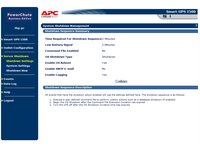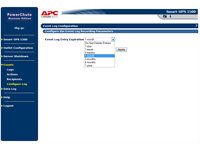Enthusiast Power Protection: Four-Way 900 W UPS Roundup
It's downright negligent to ignore the power needs of your high-end hardware. While many power users go to the trouble of tracking down solid PSUs, we recommend going a step further and investing in battery backup. We round up four enthusiast units.
SMT1500 Management Software
Windows 7 users can rejoice in that they don’t actually need any additional software to shut down their PC when battery power is low. That’s because simply connecting a USB cable between the PC and UPS allows the OS to read battery level, enabling user control of CPU power state, sleep and suspend modes, low-level and critical-level actions in the same way they would a notebook. Additional functions can be controlled from the SMT1500 front panel, but those who want to load the software will find a wider range of utilities.




APC PowerChute Web-based utility spreads the unit’s main statistics across four pages that require a password for access.


Line-interactive uninterruptable power supplies switch between battery and input power depending on input voltage. APC allows the users to define how sensitive that switching function should be. A narrower range of voltages offers increased system stability, while a broader range provides increased battery life. Automated diagnostics scheduling assures users that they’ll know far in advance before the battery needs replacement.




Load shedding is available on one bank of power connections, allowing users to determine how soon they’d like power-wasting peripherals to be shut down separately from the PC.



Additional power controls allow users to determine how much reserve power they’d like, and how quickly a shut-down system should power back up.



The SMT1500 can be set to notify users via email about monitoring errors, power events, etc. That’s handy when you’re away from the PC and need someone to tend to it.



Logging functions are rather convoluted, yet some users would rather have access to more features rather than fewer.
Get Tom's Hardware's best news and in-depth reviews, straight to your inbox.
Current page: SMT1500 Management Software
Prev Page APC Smart-UPS SMT1500 Next Page CyberPower CP1500PFCLCD-
sudeshc Have been using APC for last 2 years now without any issues what so ever.Reply
Would recommend it although they might be a bit costly but they perform really well. -
hmp_goose Soooo you have nothing to say about the TripLite atoll? Dead last? Distant second? Muddled mess? Nice part for not-our-application?Reply -
dEAne I have several units of APC and a hundred after-sales issues which remains unanswered, I opted to installed the generator set and a AVR than a UPS.Reply -
Emperus Most folks would just be happy to ignore on the need for a backup power source.. Hope this article enlightens them on getting one to protect their precious components and/or be ready if and when the situation arises.. Would be great if Tom's could put up a tier based classification on suitable UPS choices for various PC's (gaming, server, home theatre etc.)..Reply -
super_tycoon What about AVR? (Automatic Voltage Regulation) I have a CP1500AVRLCD and I've seen (at least I'm pretty sure) I've seen the AVR feature kick in when one of the local power lines got knocked out and the voltage drooped to ~100. (killed some of my non-dimmable cfl's) I went to CP's website and it claimed the pfc units still have AVR functionality. So here comes the confusion, what's the point of the voltage tolerances? If it has an AVR, why would it matter what voltage it's fed as long as there steps on the transformer? I thought the unit was supposed to take 90-140 without having to engage the battery while still passing ~120v?Reply
You've also made me want to test my non-pfc ups with my 850hx, but my gaming rig and my workstation are an hour apart.... -
aldaia This is a quite inefficient & expensive approach to the problem. We take AC and use a transformer to convert to DC and store in a battery, meanwhile another transformer is also taking AC and converting to DC to feed our components. When there is a blackout, we take DC from the battery, convert to AC and feed the computer PS where we convert back to DC to feed our components. Wouldn't be more cost effective and energy efficient to use the same unit to both feed our components with DC and the battery? Most of the time a PS has a surplus of power that can be used to charge the battery. When there is a blackout we could just take DC from battery and feed our components without the inefficient double DC->AC->DC conversion. I think an integrated UPS/PS would be cheaper (most components are replicated). That would be enough for most enthusiasts, that only need a relatively short battery life to be able to save work. A different matter is in professional environments where a UPS feeds dozens of computers that cannot be stopped. ¿Anyone knows if such a think exists?Reply -
wrxchris I've been using a CyberPower 1350AVR for the past couple years and it has been great. Gives me approx. 17 mins of runtime at idle / basic tasks (approx. 250 watts between my rig and main LCD). It's good for 810W, and I believe I picked it up on sale for $120.Reply -
g00ey I've always been wondering about the possibilities to replace the small batteries in those UPSes with standard car batteries or deep cycle (marine) batteries. Since the batteries in the UPSes are standard 12V lead cells it shouldn't be a problem and this would be a cheap way to keep the computer alive for days without external power.Reply -
nebun g00eyI've always been wondering about the possibilities to replace the small batteries in those UPSes with standard car batteries or deep cycle (marine) batteries. Since the batteries in the UPSes are standard 12V lead cells it shouldn't be a problem and this would be a cheap way to keep the computer alive for days without external power.wrongReply
